Trachelospermum asiaticum
An almost-ubiquitous ground cover in much of the American South, Asiatic jasmine is actually not jasmine at all, though it is Asian, with origins in Korea and Japan.
It takes the second half of its name from its fragrant flowers, which – under ideal conditions – perfume the air in springtime.
This fast-growing evergreen vine is appreciated for its ability to quickly cover a patch of land with a thick carpet of twining vines, even in shady areas. It’s also heralded for its tolerance of both heat and cold.

We link to vendors to help you find relevant products. If you buy from one of our links, we may earn a commission.
This plant is referred to both as “Asian jasmine” and “Asiatic jasmine.” And in Florida, they call it “minima jasmine.” You may also see it called “dwarf jasmine.” Incidentally, Florida friends, this plant is salt tolerant.
Are you thinking this plant might be the solution to your bare-earth problems? Read on to learn more!
What You’ll Learn
What Is Asiatic Jasmine?
The small, dark green leaves of this deer-resistant plant are glossy and grow from red-brown stems that scramble along the ground and up trees, fences, and possibly your leg if you stand there long enough…

Its five-petaled flowers are small, white, and delicate. If the weather is too hot, however, they won’t make an appearance.
In Austin, we very rarely see a bloom on our Asian jasmine.
T. asiaticum is hardy in USDA Hardiness Zones 7b-10. You could probably plant it in cooler zones but winter would kill it, and I can’t imagine why you’d plant a ground cover that dies in winter… But hey, you do you!

Incidentally, you may read advice on the internet where some native-plant purists spurn this vine because of its tendency to take over the garden.
I understand where they’re coming from, but if you’re looking to quickly cover a wide swath, especially in a shady area, Asian jasmine is really unbeatable.
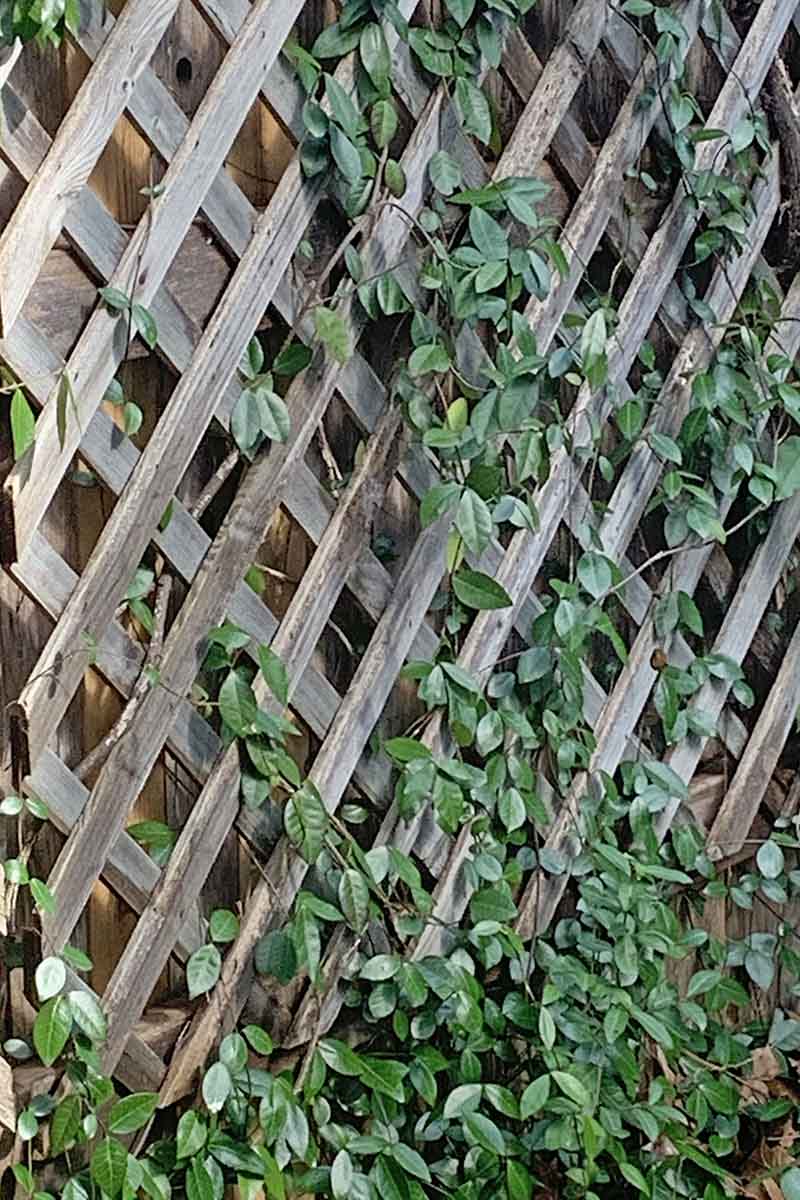
While T. asiaticum is an excellent ground cover, it does not bear foot traffic well.
If you’ve got an empty area that you’re looking to fill with something fragrant that can stand up to a little stomping, consider these culinary herbs and flowering options instead.
Also, we want to give you a heads up about another plant that is sometimes confused with Asian jasmine.
T. jasminoides, also known as star or confederate jasmine, looks similar to T. asiaticum. But it’s definitely more of a climbing vine, and it’s more likely to flower profusely under a variety of conditions.
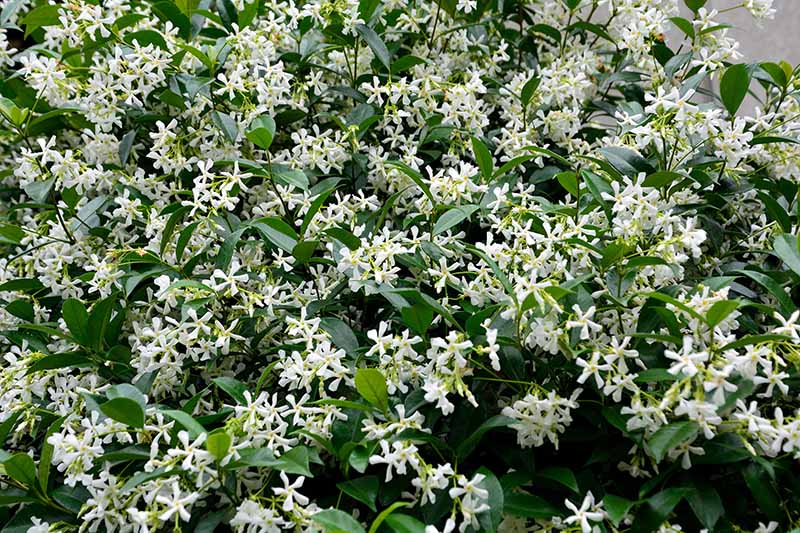
The genus from which Asiatic jasmine borrowed its name, Jasminum, includes about 200 shrubs and vines in the olive (Oleaceae) family that are native to Eurasia and Oceania. We list some of the most popular varieties here.
Common jasmine, Jasminum officinale, is native to Iran and is beloved for its attractive and fragrant flowers.
Cultivation and History
T. asiaticum was first described in Western literature by German botanists Philipp Franz von Siebold and Joseph Gerhard Zuccarini in 1846, following von Siebold’s visit to Japan in 1823-1829.
The pair labeled the plant Malouetia asiatica. Japanese botanist Takenoshin Nakai later reclassified the species according to modern taxonomic systems.
Propagation
Because Asian jasmine is a ground cover, you’ll likely want a lot of it. It does not grow from seed, but read on to learn other methods of propagation.
From Cuttings
Start by taking a 6-inch cutting from the tip of a vine shoot. Using a clean, sharp implement, cut just below a leaf.
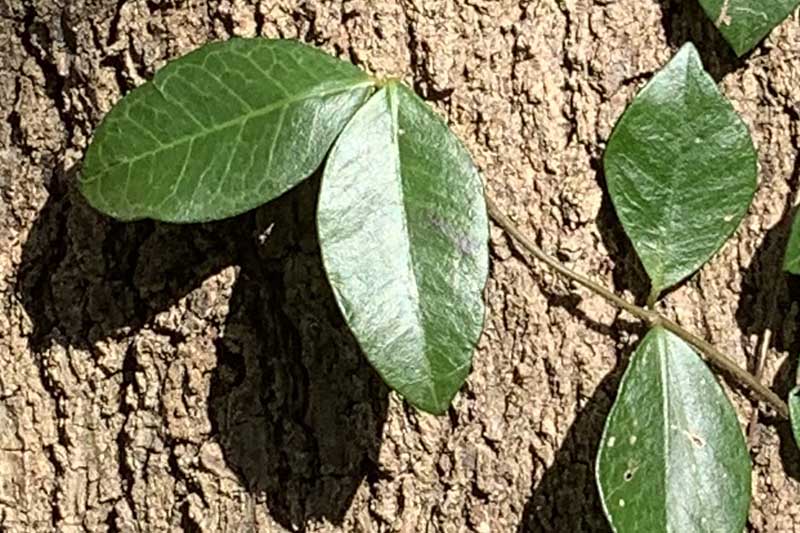
Choose a small pot with good drainage and fill it with damp sand. Insert a pencil in the center of the sand to create a hole, and then remove it.
Strip the leaves from the bottom half of the cutting, and dip the end into a rooting medium, such as a powdered rooting hormone.
Place the cutting into the hole in the sand and water well. Cover the container with a plastic bag to retain moisture, and water every day. Place it in a windowsill that gets indirect light, or outside in an area that is largely shaded.
Alternatively, after dipping it in rooting hormone, you can place your cutting into a glass of water.
After roots develop, in about a month, transplant to small containers filled with potting soil. Peat pots are terrific because you can transplant the whole thing to the ground when the rooted cuttings are ready, which will be in another 3-4 weeks.
From Seedlings or Transplants
You’ll find flats of small jasmine plugs at many nurseries, or online. Simply dig a hole about the same size as the container from which you are transplanting, and drop your plug in. Backfill if necessary, and water well.
If you live where it’s quite hot, you’re best off planting in the fall; otherwise, plant in the spring.
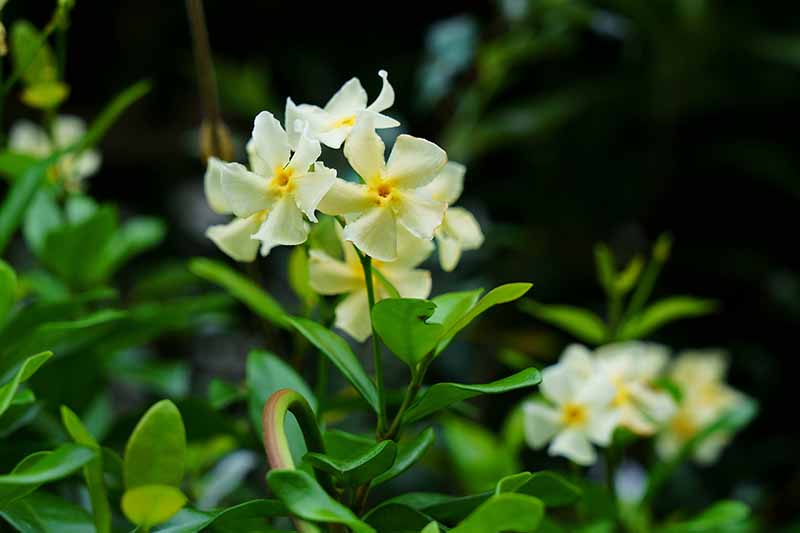
How far apart you space them is dependent on how patient you are and how big your budget is. If you want an almost-instant carpet, buy lots and lots of plants and space them eight to 10 inches apart. If budget is a factor, and you’re patient, you can purchase fewer plants and space them 18 inches apart.
Water newly transplanted plants every three or four days for about a month, and then water them once a week for another couple months.
If you already have a large area of established Asiatic jasmine, you can “borrow” 1-foot-square sections of jasmine carpet to transplant to another area of your yard.
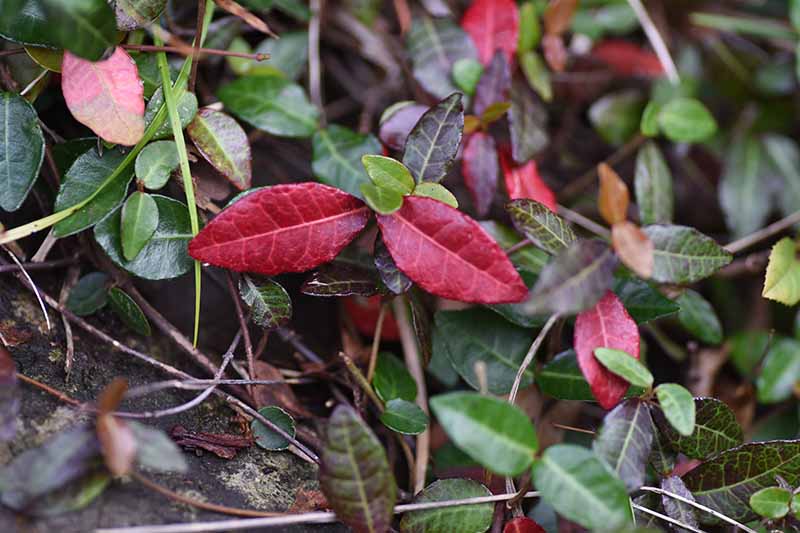
Use a very sharp shovel to cut out squares of the plant, digging up at least 3 inches of the roots. Cut these sections non-adjacently, so the remaining jasmine can fill in the areas from which you’ve removed your squares.
Transplant these sections to the new area you wish to jasmine-ify. For best results, loosen the soil of the planting site, and “settle” your squares into their new home. Water thoroughly and frequently while the squares become established.
Layering
Asiatic jasmine often produces little clumps of roots along the stem at leaf nodes, at points where it comes in contact with something it perceives as a source of nutrients. This can be the ground, a tree trunk, or a fence picket, for example.
These new roots can grow spontaneously, or you can encourage them to grow by burying a section of vine.
Either way, you can cut off the bit with the roots after they develop, and plant these independent new plants wherever you’d like.
How to Grow
T. asiaticum will tolerate a wide range of soil types, as long as it is well-draining and has a pH of 5.5 to 7.0. Mine grows perfectly well in rocky clay soil. It will grow faster and more aggressively in soils with a higher percentage of organic content.

You can plant in areas that get full sun, part sun, or full shade.
Once established, these vines are fairly drought tolerant. If you see some wilting during a long dry spell – particularly if planted in full sun – simply give the plants a good shower, and they’ll perk back up with no long-term ill effects.
The only time I water mine is in July and August, when it’s deathly hot and dry.
If you want to fertilize, apply an NPK 10-10-10 fertilizer at the start of the active growing season. I have never fertilized mine and they do very well.
Growing Tips
- Plant in sun or shade
- Irrigate mature plants when you see the leaves wilting
- Apply a balanced fertilizer in spring, if you like
Pruning and Maintenance
The only maintenance Asiatic jasmine really needs is pruning. It can spread rather assertively, and you may find it escaping its prescribed boundaries with abandon.

No matter. Just get out the string trimmer and whack away. It doesn’t mind a bit.
You can, of course, simply use pruners. But that can get tedious if you have a large area of this plant.
Some gardeners even use a lawn mower to keep these vines in check. Be sure your cutting implements are sharp, so the cut ends of the vines don’t end up unattractively ragged.
Whacking away at the ends encourages the plant to branch more from the truncated stems, so you’ll end up with a thicker carpet. Bonus!
See our complete article on how to prune and control Asian jasmine for more tips.
Cultivars to Select
While most of the T. asiaticum I see growing around Austin is just the generic, open-pollinated naturalized type, a few crafty breeders have developed some interesting cultivars.
For example, T. asiaticum ‘HOSNS,’ also known as Snow-N-Summer™, is a cultivar developed by Monrovia.
Its leaves start out pink, then turn white, then mature to variegated white and green. The plant produces small, tubular, creamy yellow flowers that are fragrant.
You can find ‘Snow-N-Summer’ in 1-gallon pots available from Fast Growing Trees.
From Japan comes T. asiaticum ‘Kiifu Chirimen,’ a dwarf variegated Asian jasmine whose small leaves grow in copper-bronze and mature to pewter-silvery green.
T. asiaticum ‘Gold Brocade’ or ‘Ojon Nishiki’ is another cultivar from Japan. It grows variegated foliage that emerges in red and orange, and then matures to gold and deep green.
Managing Pests and Disease
The only disease problem you may see with Asian jasmine is leaf spot caused by the fungus Cercospora, which produces individual tan or light brown spots with red-purple borders.
If you have a severe infection, which is rare, you can treat your plants with a fungicide. Otherwise, don’t worry about it, because rarely is fungus a severe problem for Asiatic jasmine.
Best Uses
Asian jasmine is most often used as a ground cover, though some of the cultivars that are available make attractive additions to hanging planters.
Quick Reference Growing Guide
| Plant Type: | Vine, perennial | Flower / Foliage Color: | White; dark green, variegated |
| Native to: | Japan, Korea | Water Needs: | Low |
| Hardiness (USDA Zone): | 7b-10 | Maintenance: | Low |
| Season: | Spring, summer | Tolerance: | Drought, salt |
| Exposure: | Full sun, part sun, full shade | Soil Type: | Any, except waterlogged |
| Spacing: | 18 inches | Soil pH: | 5.5-7 |
| Planting Depth: | Same depth as container | Soil Drainage: | Well-draining |
| Height: | 18 inches | Uses: | Groundcover, hanging baskets |
| Spread: | 10 feet | Family: | Apocynaceae |
| Growth Rate: | Fast | Genus: | Trachelospermum |
| Pests & Diseases: | Leaf spot | Species: | asiaticum |
A Japanese Import for the Garden
While not native to the US and perhaps a bit aggressive, Asiatic jasmine is a fantastic ground cover, particularly in shady areas where not much else will grow.
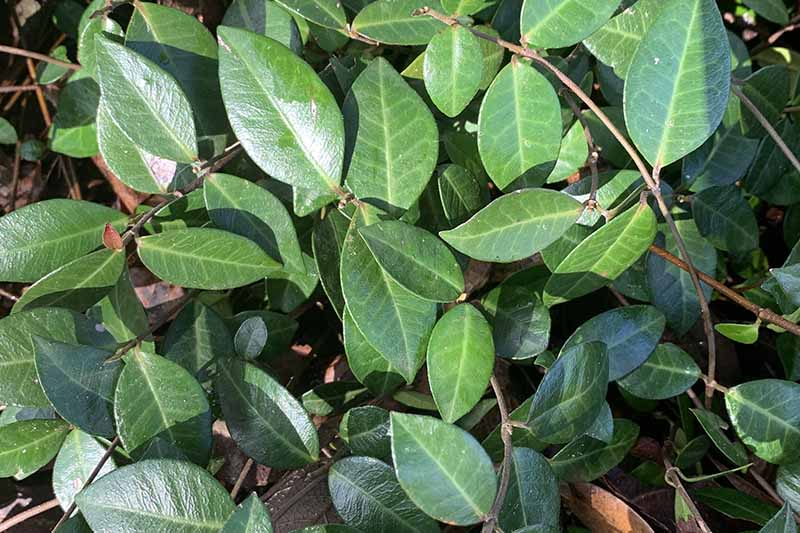
It’s drought tolerant, un-pestered by bug or beast, and frost tolerant. Its small, deeply colored leaves make an attractive carpet of green.
Have you grown Asiatic jasmine? Share your expertise in the comments section below.
Looking for information about other drought tolerant plants? Check out these articles next:
- How to Grow Texas Mountain Laurel
- How to Grow and Care for Spirea Bushes
- How to Grow and Care for American Beautyberry Shrubs
Photos by Gretchen Heber © Ask the Experts, LLC. ALL RIGHTS RESERVED. See our TOS for more details. Product photo via Fast Growing Trees. Uncredited photos: Shutterstock.
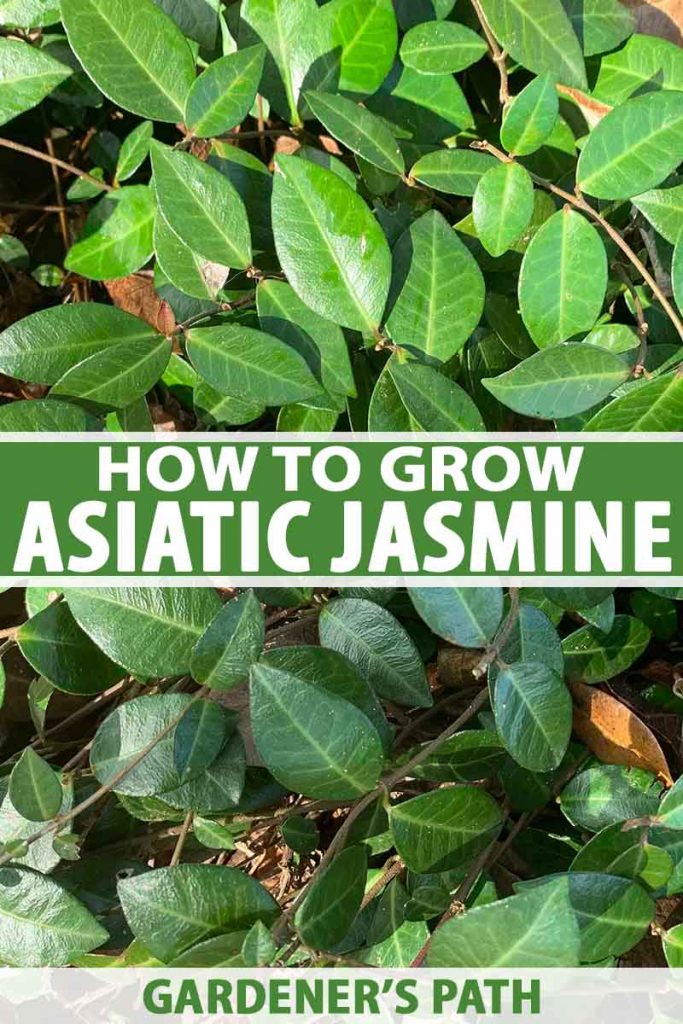

If I plant 8- 18 inches apart and it takes 2 seasons to fill in will I end up with weeds also or will the jasmine eventually choke them out? I am planting in area that had some grass which I’m killing off but some could try to come back.
We planted some under a tree where grass is hard to grow. At first we did have some grass still trying to come up, but after the jasmine got thick it has choked the grass out. We just trim with a string trimmer if it gets scraggly and it looks good. I will tell you that it has been growing five years. Takes a while for it to get thick.
Hi Gretchen,
Our Asiatic jasmine has developed white leaves (very evenly white) that are not powdery. Could this be an indication for a need for fertilizer? Please let me know your thoughts. We have never fertilized the ivy (in 11 years).
Can you share photos, Veronica? Some varieties do have leaves that are white when they are immature, but since it sounds like this is a new feature of a plant that you’ve had for quite awhile, I suspect that this is not the issue at hand. Most won’t need much in the way of fertilizer, unless the leaves are yellowing.
Hi, I recently have been battling what I now understand to be Japanese Stiltgrass growing in my asiatic jasmine plants. It has taken over one side of my plants, and basically killed out the jasmine. I am at my end. Any ideas or suggestions? I visited a garden shop, and the resident gardener told me to try Crabgrass killer; which comes in powder form, which I did on a test area. It’s very expensive and doesn’t cover much sq.ft. I checked back and noticed that it was also killing the jasmine, at least turning the leaves black 🙁 Don’t know… Read more »
Hi Steven! That is so stressful. Are you positive that it’s Japanese Stiltgrass? It should have those silvery hairs down the center of each leaf blade. You can attach a photo to a comment if you’d like. This only matters, really, for treatment purposes. If it IS Japanese Stiltgrass, unfortunately the best choice is to pull all the weeds and keep a close eye out for any future outbreaks. Using insecticides that are effective on the stiltgrass can also kill the Asiatic Jasmine, as you’ve probably noticed. Now is actually a good time to pull Japanese Stiltgrass, as long as… Read more »
Hi Laura, thanks so much for the time to respond. Attache are some pictures. What do you think?
Hi I have 2000 sq.ft of asiatic jasmine in the front of my house it is about five years old. I haven’t had any problems except weeds which I hand weeded every year. My jasmine is dying the leave are brown and dry. Has anyone ever had this problem three month ago it was beautiful green and healthy don’t know what to do.
Oh, Frederick, I hate to hear of the demise of your once-healthy Asiatic jasmine. There’s a chance it succumbed to a fungal disease from too much moisture. Before we keep trouble shooting, can you let us know if you’ve had a bout of really rainy weather recently?
My gardener is proposing to plant 600 (!) of these 1 gallon plants along the side of my house. Two questions: what is the rule of thumb for how many of these to plant per square foot, especially given that they grow so fast. Second question: this side of the house is shady and tends to get a lot of water in the summer florida rain. Will that work for this variety of plant?
I planted Asiatic Jasmine in my front yard to avoid mowing. Stays green and uses very little water. It is very hard to keep to a reasonable level and Fall leaves are impossible to rake out.. The only way to keep it under control is to hire professionals to blow leaves and weed eat to a reasonable level. They charge $150 per hour and it takes 3 hours. The sidewalk edges need a monthly trim which I do. Just have to watch out for critters that live in it! I am saving on paying for weekly mowing and fertilizer and… Read more »
Hello Susan. I find the idea of minimizing your lawn maintenance with this approach so appealing and am glad to hear Asiatic jasmine is working out for you!
Hello Val. I would maybe get a second opinion from your local Ag Extension office? I can tell you that you’ll have an “instant carpet” effect when you plant them 8-10 inches apart, so you can factor that in on your evaluation of this landscape approach.
But your second question concerns me a bit more since the water needs for Asiatic jasmine are low, and they may not do well in torrential downpours in the summer. Good luck whatever you decide!
I planted asiatic jasmine about a year ago in a mostly shady but sometimes sunny area (in Houston TX). At the time it was bare dirt, but there had been grass there in the past. I started by planting 18 inches apart then later added more. It has really not grown at all, and the area is covered in weeds and grass that I am unable to keep up with by removing them by hand. You can barely see the jasmine plants among the weeds. It’s basically been a disaster. Is there anything I can do besides try to weed… Read more »
Hello Holly. I am sorry to hear about your frustrating experience! Asiatic jasmine does need well-draining soil, so if it was planted in compacted, bare dirt, that may have started the trouble. I can sympathize with not wanting to keep weeding and hoping for the best. Do you have the resources to dig up as many of the plants as you can? You would need to wait until fall for the best results. But instead of isolated weeding, I imagine you would be better off salvaging the Asiatic jasmine plants you could and then weeding and re-tilling the whole area… Read more »
I appreciate what I am certain is a well-meaning reply, but there is no way on earth that I would do this. I planted asiatic jasmine because it’s supposed to be easy. If I was able and willing to put this much work into this one area of the yard I’m sure I could make it into some kind of earthly paradise. If I really have to remove everything I would just hire someone to rip it out and put down sod. Why is gardening advice always like this? I really do appreciate it. But we are from different planets.
I think it all starts with the soil, Holly. And I understand your frustration! Alkaline clay is common in Houston, and though this species is known as a fast-growing ground cover that’s suited to your growing zone, it prefers an area with good drainage as Rose mentioned, as well as acidic soil. The number of hours of sun this area receives is important as well. Grass tends to prefer slightly acidic to neutral soil, and many plants can tolerate shade. But if the soil there is naturally too alkaline, or plants are receiving just a few hours of sun per… Read more »
The problem is that the weeds and grass, which I am only able to pull sporadically, grow back faster than the jasmine grows, so it does not have the opportunity to fill in. I was thinking maybe I could plant something that would keep the weeds down but still give way to the jasmine as the jasmine grows. Maybe mini clover? Or just put in a lot more jasmine? There are also dead leaves on the ground. I have been removing them assuming they are preventing the jasmine from spreading, but perhaps I’m making it worse by giving the weeds… Read more »
You’re welcome, Holly. Grass can be tricky to get rid of! An intentionally planted cover crop like red clover could work, and it’s easy to sow seed by broadcasting it over the area. I’d recommend a good layer of simple leaf mulch to help keep weeds down between plantings. You could even put newspaper down to kill the grass, mulch over that, and then remove it later.
Hi! I live in south Texas and I just planted Asian jasmine 2 days ago. When I planted they were beautiful and healthy. I planted early in the morning and gave them a good watering I also watered them that evening a little bit. I did not water the next morning but when I went out around 3 pm a lot of the leaves had turned brown. Also of note, the weather has been hovering around 105-108 degrees and these are planted where they get full sun from about 12 noon to 7 pm. Everywhere I read it says to… Read more »
Sorry Elisa, but those brown leaves won’t turn green again. I’m so sorry we didn’t see your question sooner! Asian jasmine plants can tolerate a wide range of adverse conditions once they’re established, but new transplants require some extra TLC. Transplanting into new conditions gives plants a bit of a shock, and it’s best to give them a chance to adapt gradually before tossing them into the deep end. This might involve keeping them indoors or in deep shade for the majority of the time and bringing them out to the sunny planting area for just half an hour before… Read more »
Hi Gretchen, I’m in the north Georgia area and I have a sloped portion of my property that I’m trying to decide what to use as a groundcover. The area is about 10′ wide and 200′ long, the slope is a 2:1 slope. Clayey soil. Asiatic Jasmine was recommended to me. I have stripped the area of all plants and grasses and only have a couple of trees. I installed heavy duty (weaved) landscape fabric on the area to control weeds. If I plant the Asiatic Jasmine in this situation, will it be able to spread/grow across the fabric? Obviously… Read more »
What did you place over top of the fabric, Scott? What kind of trees are growing in the area, and about how old are they? Creating the full ground cover that you’re looking for will require a bit of extra maintenance at first, and your best option is to think of the fabric as a temporary solution to help keep weeds down. Essentially, planting any type of ground cover and using landscaping fabric aren’t readily compatible, and you need to consider those trees as well. These plants won’t spread across the fabric the way you’re hoping they might. Holes cut… Read more »
Hello I live in Tampa, FL. Have had a large area 25’ x30’ of Minima jasmine for 18 years 1 year ago it a patch started to die and has spread to about a 10’ x 15’ area I have treated with fungicide thyomil & copper sulfate. It hasn’t improved. It is under large oaks that have plenty of roots coming to the surface but the whole area is like that. I am at my wits end. I fertilize and water regularly, everything else is healthy except for this one area. Any suggestions are greatly appreciated.
How often do you fertilize and what do you use? What prompted you to start treating with fungicide- did the plants exhibit any notable symptoms before those patches died off? I recommend that you stop watering right away. Well-established plants like you’ve described shouldn’t require supplemental irrigation except perhaps during periods of extreme drought, and too much moisture can lead to fungal disease. If this is a shaded area under cover from the oaks, extra moisture will evaporate slowly, providing the perfect environment for fungi to spread. It’s possible that certain patches have succumbed to old age – they can… Read more »
I live in Dallas and have a very thick bed of jasmine under oak trees. It has been here for years and years as I have lived here ten years and I think it was just as thick and lovely when I moved in. It has always been very healthy without any care. I only water in extreme dry spells. If I plant daffodils, jonquils or other bulbs with long stem, will they come up and be okay, It will not be easy to dig through the jasmine to plant the bulbs, so I don’t wish to waste a lot… Read more »
What type of soil do you have, Earl? As long as the ground is workable, it drains well, and it’s not too lean, this sounds like a great idea. Flowering bulbs can make a lovely addition to the jasmine beds, and jonquils or other types of daffodils should do well in your hardiness zone. In Dallas, you’re just on the cusp of their preferred range. Under oak trees, the daffodils should be able to receive plenty of sun to bloom before the trees leaf out. As long as the bulbs are planted deeply enough, and preferably in the fall, they… Read more »